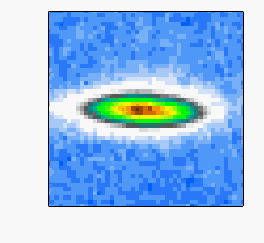The Hall effect has been observed for the very first time in a gas of ultracold atoms by researchers from the National Institute of Standards and Technology (NIST). This discovery will enable scientists to enhance their knowledge about the physics of the quantum Hall effect and superfluidity.
 Starting with a cloud of about 20,000 atoms, the researchers varied the trapping force, pushing the atoms together and pulling them apart, to simulate the movement of charge carriers in an alternating current. In response, the atoms begin to move in a manner mathematically identical to how charged particles experiencing the Hall effect would move--at right angles to both the direction of the "current" flow and the artificial magnetic field. This causes the tilting motion.
Starting with a cloud of about 20,000 atoms, the researchers varied the trapping force, pushing the atoms together and pulling them apart, to simulate the movement of charge carriers in an alternating current. In response, the atoms begin to move in a manner mathematically identical to how charged particles experiencing the Hall effect would move--at right angles to both the direction of the "current" flow and the artificial magnetic field. This causes the tilting motion.
The Hall effect was discovered by Edwin Hall in 1879 and can be easily visualized in a copper plate when current flows along the length of the copper plate. A magnetic field is applied to the electric current and the path of the charge carriers is deflected by introducing force in the third direction. This force in induced in the third direction to the current flow and the magnetic field at right angles. The charge carriers are thus pushed towards the plate’s side and an electrical potential or Hall voltage is induced. Hidden properties of electrical systems are measured by the Hall voltage.
NIST’s work on generating synthetic magnetic and electric fields was referred to for measuring the Hall effect in a Bose-Einstein condensate. Lasers are used by the group to tie the energy of the atom to their momentum by placing two internal states into a superposition thus causing the electrically neutral atoms to act like charged particles. A cloud of almost 20,000 atoms is collected in a loose ball and the researchers push the atoms together and then pull them apart in order to simulate the movement of charge carriers in alternating current. As a result of this, the atoms start moving in directions according to the artificial magnetic field and the flow of current.
Lindsay LeBlanc, a researcher from NIST, stated that the physics of superfluidity can be analyzed by another tool offered as a result of measuring the Hall effect. The physics of superfluidity is a low-temperature quantum-based condition that allows the flow of liquids without friction. Fundamental constants are determined by the quantum Hall effect that quantizes the ratio of the voltage and the current passing through the material.